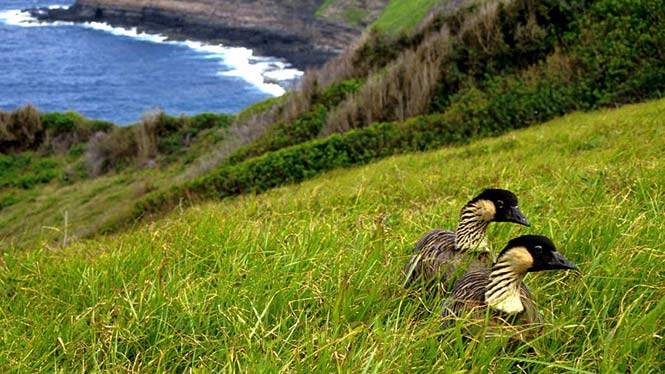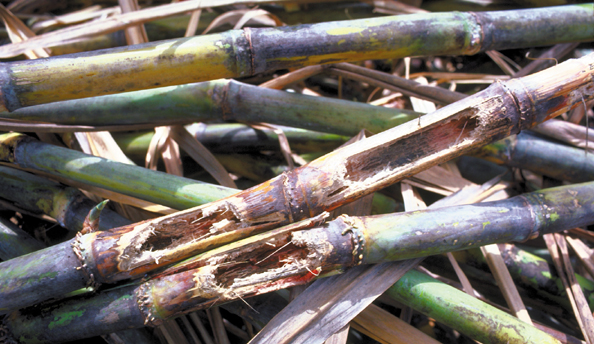
An invasive species is an organism or group of organisms that have been introduced into an environment which is not natural to them, and that could potentially cause harm to the natural environment or to human health.
 |
| Nene- The Hawaiian State Bird |
Hawaii was inhabited by plants and animals long before it was ever discovered by humans. Natives claim that "wind, wings and waves" brought life to the islands. Wind carried birds, wings of the birds held seeds that dropped into the earth and grew in the fertile soil, and waves carried debris with other plant life.
The island flourished.
Hawaii was discovered by the Polynesians nearly 1,600 years ago. Carried by waves, they brought food and resources in canoes; such as swine for food and grain for farming. Rats hid in their supplies and scurried out onto the land.

In the 1700’s the Europeans crossed the ocean and landed upon the island. Led by Captain Cook, the ships unloaded in Hawaii bringing with them more rats as well as the European race of swine.
The two different races of swine hybridized, creating a larger, stronger animal that ran wild throughout the island. Natural behaviors of swine are to root in the ground and feed off plant roots. This act, combined with the opportunistic feeding style of swine, killed many plants and caused soil erosion. The swine brought about the total extinction of many plants only native to Hawaii, and the lack of any defense system in place allowed their growth to continue unchecked. The once beautiful landscape was devastated by the impact of these destructive animals.
 Behind the scenes, the rat population continued to grow. Another opportunistic feeder; they ate plants, seeds, roots, eggs, reptiles, and other small mammals. Since many birds, including the Hawaiian state bird, the Nene, nest on the ground, the rats could eat their eggs effortlessly. Sugarcane became very popular in Hawaii as a profitable crop. The rats grew fond of the plant, destroying many sugar cane fields. Farmers grew desperate. Before thoroughly researching the comparative natural behaviors of these creatures, they began shipping the Indian mongoose from the island of Jamaica. Mongoose are known to eat rats, as well as many other creatures. They were released into the fields, expected to kill the rats that tore through their crops. What wasn’t properly considered was the fact that unlike mongoose, rats are nocturnal. Mongoose would prey on the small rats that would occasionally run by them in the early morning or near dusk, but didn’t kill the mass quantities that the farmers were hoping for. Instead, the mongoose preferred to eat bird eggs that lie immobile on the ground. Hawaii's birds weren’t accustomed to having predators hunt them, which made them an easy target for the voracious mongoose. Their diet also consisted of reptiles, insects, and baby sea turtles. Getting into homes, tearing through garbage, and destroying plants and crops of the locals who live on the island made the animals a terrible pest. Once again, desperate efforts to control this rising invasive species population rely almost solely on trapping and poisoning them.
Behind the scenes, the rat population continued to grow. Another opportunistic feeder; they ate plants, seeds, roots, eggs, reptiles, and other small mammals. Since many birds, including the Hawaiian state bird, the Nene, nest on the ground, the rats could eat their eggs effortlessly. Sugarcane became very popular in Hawaii as a profitable crop. The rats grew fond of the plant, destroying many sugar cane fields. Farmers grew desperate. Before thoroughly researching the comparative natural behaviors of these creatures, they began shipping the Indian mongoose from the island of Jamaica. Mongoose are known to eat rats, as well as many other creatures. They were released into the fields, expected to kill the rats that tore through their crops. What wasn’t properly considered was the fact that unlike mongoose, rats are nocturnal. Mongoose would prey on the small rats that would occasionally run by them in the early morning or near dusk, but didn’t kill the mass quantities that the farmers were hoping for. Instead, the mongoose preferred to eat bird eggs that lie immobile on the ground. Hawaii's birds weren’t accustomed to having predators hunt them, which made them an easy target for the voracious mongoose. Their diet also consisted of reptiles, insects, and baby sea turtles. Getting into homes, tearing through garbage, and destroying plants and crops of the locals who live on the island made the animals a terrible pest. Once again, desperate efforts to control this rising invasive species population rely almost solely on trapping and poisoning them.
Once the detrimental effects of this species were realized, many desperate efforts were made to rid the island of these creatures. Throughout the years, hunting, trapping, snaring, and poisoning swine became a hobby for many Hawaiians in hopes of gaining control of the rising population.
There are various other invasive species in Hawaii, many of which were brought to the islands by visitors. Many invasive plants are difficult to spot to someone who isn’t familiar with plants species. Other invasive creatures include the Burmese python, brown tree snake, cane toad, coqui frog, feral cats and dogs, etc. Many clubs and groups in Hawaii are fighting to get their island back from these pesky, destructive creatures. Their top priorities are to raise awareness to avoid further invasion and give information to contact the proper authorities when there are any sightings of these animals. If you live in Hawaii, or are just visiting, please be aware of your surroundings. Listed below are proper contacts to reach if you see any of these animals on the islands.
Big Island Invasive Species Committee (BIISC)
23 E. Kawili St.
Hilo, HI 96720
Phone: (808) 933-3340
Fax: (808) 933-3326
Hotline: (808) 961-3299
Kauai Invasive Species Committee (KISC)
P.O. Box 1998
Lihue, Hawaii 96766
Office: (808)821-1490
Fax: (808)821-1492
E-mail: KISC@hawaii.edu
Location: 7370K Kuamoo Road, Kapaa, Hawaii
P.O. Box 1998
Lihue, Hawaii 96766
Office: (808)821-1490
Fax: (808)821-1492
E-mail: KISC@hawaii.edu
Location: 7370K Kuamoo Road, Kapaa, Hawaii
P.O. Box 983
Makawao, Hawaii 96768
Phone: 808-573-MISC (6472) or 573-6471
Fax: 808-573-6475
Location: 820 Piiholo Road, Makawao, Hawaii
Molokai Invasive Species Committee (MoMISC)
P.O. Box 220
Kualapuu, Hawaii 96757
Office: 808-553-5236
Kualapuu, Hawaii 96757
Office: 808-553-5236
Oahu Invasive Species Committee (OISC)
743 Ulukahiki Street
Kailua, HI 96734
Office: (808) 266-7994
Fax: (808) 266-7995
e-mail: oisc@hawaii.edu
743 Ulukahiki Street
Kailua, HI 96734
Office: (808) 266-7994
Fax: (808) 266-7995
e-mail: oisc@hawaii.edu
Helpful website:
--> http://www.invasivespeciesinfo.gov/index.shtml
Works cited:
What is an invasive species? (2012, November 28). United States Department of Agriculture: National Agriculture Library. Retrieved from http://www.invasivespeciesinfo.gov/whatis.shtml#.UTOEz4XSHAk
Invasive Species Committee of Hawaii. Hawaii Invasive Species Council. Retrieved from http://www.hawaiiinvasivespecies.org/iscs/
Kauai [Photo]. (2011). Retrieved from Top Ten Best Beaches in the World website: http://www.best-beaches.com/images/kauai/kauai-hawaii-pictures.jpg
The Nene Goose [Photo]. (2011). Retrieved from Aloha from Hawaii website: http://www.aloha-hawaii.com/wp-content/uploads/2009/11/nene.jpg
Hemp in British and Australian Colonial History [Photo]. (2011). Retrieved from Nimbin Wave website: http://www.nimbinwave.com/wp-content/uploads/2011/05/the-bounty.jpg
Rat damage to sugar cane in Barbados [Photo]. (2004). Retrieved from Saved By Bedbugs website: http://www.gotouring.com/howdy/book1/images/121-Barb-cane-damag.jpg
DiscoveryNetworks. Hogs Gone Wild- The Hog Whisperer [Video File]. Retrieved from https://www.youtube.com/watch?v=7RRr_d3p7T0
VOAvideo. Hawaii's Birds Threatened by Invasive Predators [Video File]. Retrieved from https://www.youtube.com/watch?v=JLarD5vhdKk&playnext=1&list=PL1D7C32145D0290B6&feature=results_video
Tilman, D. (2004). Niche tradeoffs, neutrality, and community structure: A stochastic theory of resource competition, invasion, and community assembly. Proceedings of the National Academy of Sciences, 101(30), 10854–10861. doi:10.1073/pnas.0403458101
Primtel, D. (2005). Update on the environmental and economic costs associated with alien-invasive species in the United States. Ecological Economics, 52(4), 1088–1091. doi:10.1073/pnas.0308547102
Invasive Species Committee of Hawaii. Hawaii Invasive Species Council. Retrieved from http://www.hawaiiinvasivespecies.org/iscs/
Kauai [Photo]. (2011). Retrieved from Top Ten Best Beaches in the World website: http://www.best-beaches.com/images/kauai/kauai-hawaii-pictures.jpg
The Nene Goose [Photo]. (2011). Retrieved from Aloha from Hawaii website: http://www.aloha-hawaii.com/wp-content/uploads/2009/11/nene.jpg
Hemp in British and Australian Colonial History [Photo]. (2011). Retrieved from Nimbin Wave website: http://www.nimbinwave.com/wp-content/uploads/2011/05/the-bounty.jpg
Rat damage to sugar cane in Barbados [Photo]. (2004). Retrieved from Saved By Bedbugs website: http://www.gotouring.com/howdy/book1/images/121-Barb-cane-damag.jpg
DiscoveryNetworks. Hogs Gone Wild- The Hog Whisperer [Video File]. Retrieved from https://www.youtube.com/watch?v=7RRr_d3p7T0
VOAvideo. Hawaii's Birds Threatened by Invasive Predators [Video File]. Retrieved from https://www.youtube.com/watch?v=JLarD5vhdKk&playnext=1&list=PL1D7C32145D0290B6&feature=results_video
Tilman, D. (2004). Niche tradeoffs, neutrality, and community structure: A stochastic theory of resource competition, invasion, and community assembly. Proceedings of the National Academy of Sciences, 101(30), 10854–10861. doi:10.1073/pnas.0403458101
Primtel, D. (2005). Update on the environmental and economic costs associated with alien-invasive species in the United States. Ecological Economics, 52(4), 1088–1091. doi:10.1073/pnas.0308547102
No comments:
Post a Comment